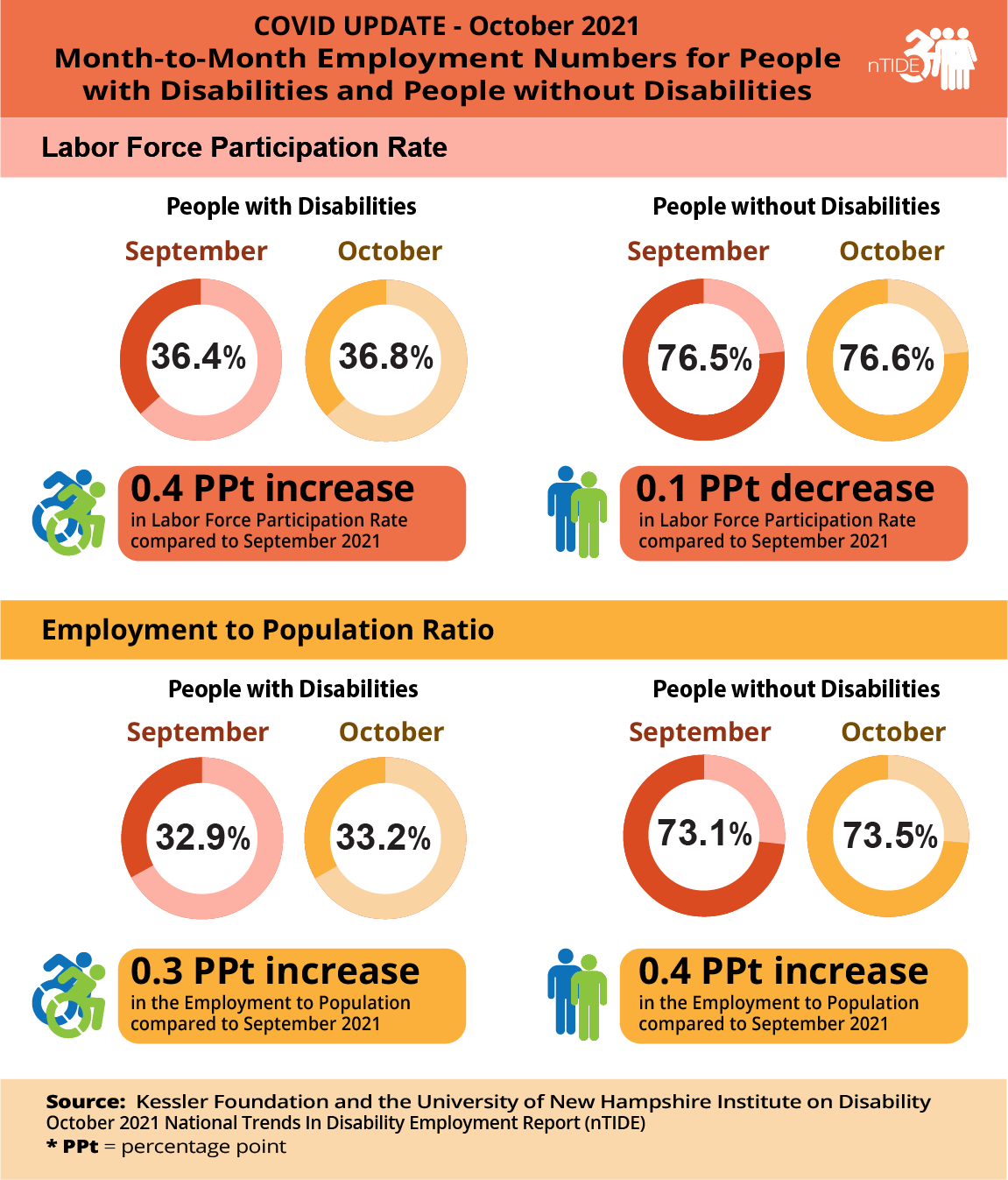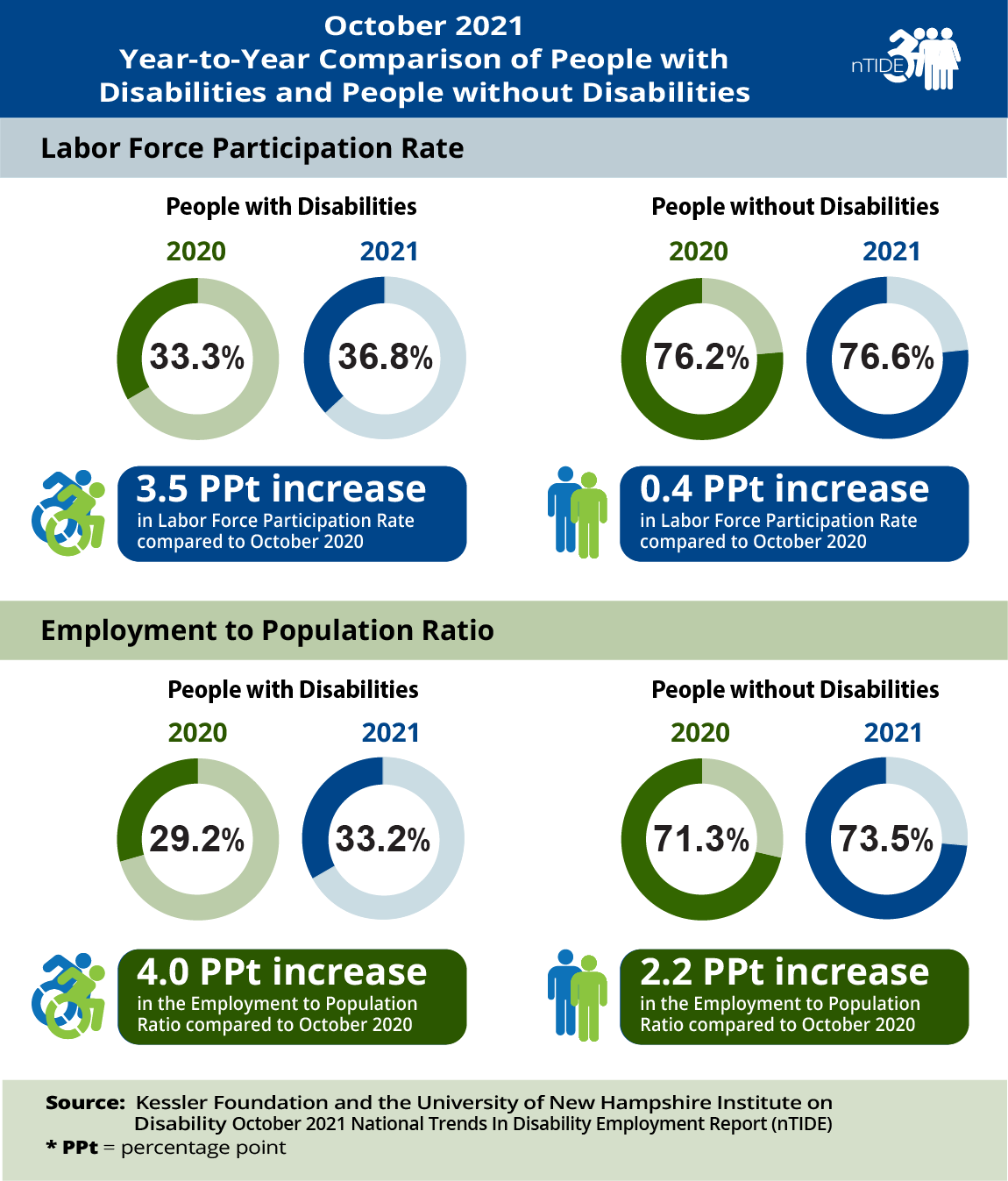nTIDE October 2021 Jobs Report: Employment for people with disabilities reaches historic levels
National Trends in Disability Employment (nTIDE) – issued semi-monthly by Kessler Foundation and the University of New Hampshire
East Hanover, NJ – November 5, 2021 – In October, the major employment indicators for people with disabilities reached their highest recorded levels since September 2008, when reporting for this cohort was begun by the Bureau of Labor Statistics (BLS), according to today’s National Trends in Disability Employment – Monthly Update (nTIDE), issued by Kessler Foundation and the University of New Hampshire’s Institute on Disability (UNH-IOD). Substantial gains were reflected in year-to-year comparisons, as well as for month-to-month data.

This graphic compares the economic indicators for September 2021 and October 2021, showing increases for people with and without disabilities
nTIDE COVID Update (month-to-month comparison)
In the BLS Jobs Report released Friday , the employment-to-population ratio for working-age people with disabilities increased from 32.9 percent in September 2021 to 33.2 percent in October 2021 (up 0.9 percent or 0.3 percentage points). For working-age people without disabilities, the employment-to-population ratio also increased from 73.1 percent in September 2021 to 73.5 percent in October 2021 (up 0.5 percent or 0.4 percentage points) . The employment-to-population ratio, a key indicator, reflects the percentage of people who are working relative to the total population (the number of people working divided by the number of people in the total population multiplied by 100).
“The employment of people with disabilities is pushing past historic levels, as well as pre-pandemic levels,” remarked Andrew Houtenville, PhD , professor of economics and the research director of the University of New Hampshire’s Institute on Disability. “The October 2021 employment-to-population ratio of 33.2 percent exceeds the September 2008 employment-to-population ratio of 32.7 percent,” he noted, “which is when the BLS first started to officially report employment figures for people with disabilities.”
The labor force participation rate for working-age people with disabilities increased from 36.4 percent in September 2021 to 36.8 percent in October 2021 (up 1.1 percent or 0.4 percentage points). For working-age people without disabilities, the labor force participation rate also increased from 76.5 percent in September 2021 to 76.6 percent in October 2021 (up 0.1 percent or 0.1 percentage points). The labor force participation rate is the percentage of the population that is working, not working and on temporary layoff, or not working and actively looking for work.
“Over the last three months, we saw improvement in the labor force participation rate for people with disabilities,” said John O’Neill, PhD, director of the Center for Employment and Disability Research at Kessler Foundation. “This may be a trend where people with disabilities are more comfortable returning to work as the COVID delta variant comes under control,” he added, “and employers continue to offer incentives to attract workers.”

This graphic compares the economic indicators for October 2020 and October 2021, showing increases for people with and without disabilities.
Year-to-Year nTIDE Numbers (comparison to the same time last year)
The employment-to-population ratio for working-age people with disabilities increased from 29.2 percent in October 2020 to 33.2 percent in October 2021 (up 13.7 percent or 4 percentage points). For working-age people without disabilities, the employment-to-population ratio also increased from 71.3 percent in October 2020 to 73.5 percent in October 2021 (up 3.1 percent or 2.2 percentage points).
The labor force participation rate for working-age people with disabilities increased from 33.3 percent in October 2020 to 36.8 percent in October 2021 (up 10.5 percent or 3.5 percentage points). For working-age people without disabilities, the labor force participation rate also increased from 76.2 percent in October 2020 to 76.6 percent in October 2021 (up 0.5 percent or 0.4 percentage points).
In October 2021, among workers ages 16-64, the 5,186,000 workers with disabilities represented 3.6 percent of the total 144,505,000 workers in the U.S.
Ask Questions about Disability and Employment
Join our nTIDE Lunch & Learn series today, November 5, at 12:00 pm Eastern. This live broadcast, hosted via Zoom Webinar, offers attendees Q&A on the latest nTIDE findings, provides news and updates from the field, as well as invited panelists to discuss current disability-related findings and events. Today, Purvi Sevak PhD, principal researcher from Mathematica, and Richard Tulikangas Director of Linking Learning to Careers, a statewide initiative through VocRehab Vermont, join Drs. Houtenville and O’Neill, and Denise Rozell, Policy Strategist at AUCD. Join live or watch the recordings at: ResearchonDisability.org/nTIDE .
nTIDE COVID Update – Friday, November 19 at 12:00 pm Eastern
Stay tuned for our mid-month update about the employment of people with disabilities as we follow the impact of COVID-19 and look at the numbers in more detail.
NOTE: The statistics in the nTIDE are based on Bureau of Labor Statistics numbers but are not identical. They are customized by UNH to combine the statistics for men and women of working age (16 to 64). nTIDE is funded, in part, by grants from the National Institute on Disability, Independent Living and Rehabilitation Research (NIDILRR) (90RT5037) and Kessler Foundation.
About Kessler Foundation
Kessler Foundation, a major nonprofit organization in the field of disability, is a global leader in rehabilitation research that seeks to improve cognition, mobility, and long-term outcomes -- including employment -- for people with neurological disabilities caused by diseases and injuries of the brain and spinal cord. Kessler Foundation leads the nation in funding innovative programs that expand opportunities for employment for people with disabilities. For more information, visit KesslerFoundation.org .
About the Institute on Disability at the University of New Hampshire
The Institute on Disability (IOD) at the University of New Hampshire (UNH) was established in 1987 to provide a coherent university-based focus for the improvement of knowledge, policies, and practices related to the lives of persons with disabilities and their families. For information on the NIDILRR-funded Employment Policy and Measurement Rehabilitation Research and Training Center, visit ResearchOnDisability.org.